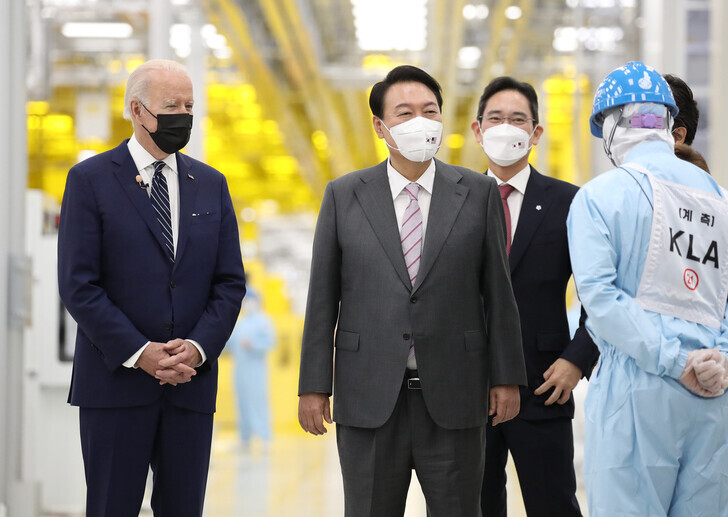Will Biden’s push for S. Korea-US “semiconductor alliance” help Korea catch up to Taiwan?
The fact that the US president’s trip to Korea started off with a visit to a Samsung chip factory demonstrates his commitment to reorganizing the chip supply chain around the US

US President Joe Biden (left) and South Korean President Yoon Suk-yeol (center) receive a tour from Samsung Electronics’ Vice Chairman Lee Jae-yong (center back) around the company’s chip factory in Pyeongtaek, Gyeonggi Province, on May 20. (pool photo)
Semiconductors are a key word and a central item on the agenda of the summit between South Korean President Yoon Suk-yeol and US President Joe Biden, who intend to strengthen their two countries’ economic and technology alliance. They’re also a critical field in which the US hopes to reorganize the global supply chain to defend its hegemony as it competes with China. That’s why Yoon and Biden’s first official meeting occurred in the form of a visit to Samsung Electronics’ chip factory on Friday afternoon.
Samsung Electronics Vice Chairman Lee Jae-yong gave the two leaders a tour of the factory’s ultrafine production line and showed them prototypes. For Biden, that functioned as a preliminary inspection of the chip plant that Samsung has agreed to build in Texas.
The semiconductor industry and experts generally agree that reorganizing the chip supply line around the US is an unavoidable choice and should be proactively regarded as an opportunity. While Samsung Electronics and SK Hynix control 70% of the global market for memory semiconductors, they lag far behind in system semiconductors, also known as logic chips or microprocessors — a more important kind of chip.
Intel, Apple, Qualcomm and Nvidia are the market leaders in designing system semiconductors (fabless manufacturing), while Taiwan-based TSMC is by far the strongest player when it comes to producing those chips (the foundry model).
According to market analysis firm TrendForce, TSMC controls 53% of the foundry market, while Samsung Electronics stands at 18%. The gap between their market shares is even more pronounced in high value-added ultrafine processes, which handle materials measuring less than 10 nanometers (1 nanometer = 1 billionth of a meter).
Three years ago, Samsung Electronics began investing an astronomical 171 trillion won (US$151 billion) with the goal of taking the top spot in the system semiconductor market by 2030, but it hasn’t been able to narrow the gap. Apple and Intel are among the 90% of American companies that have TSMC produce their chips exactly as designed.
While the levels of ultrafine technology and productivity (that is, yield) are important, a fundamental limitation of Samsung’s foundry business is that companies that compete with Samsung in smartphones and communication devices are reluctant to give Samsung chip orders.
“The US is the world’s biggest market, complete with every aspect of infrastructure, including not only customers but also design, original technology, and major materials and equipment. Receiving incentives and support from the US government through semiconductor cooperation would help with foundry competition,” said a source from the Korea Semiconductor Industry Association.
The US has been aggressively pushing to reorganize the semiconductor supply chain after the supply of vehicle chips was disrupted by the COVID-19 pandemic last year. Biden has allocated US$52 billion to the area of semiconductors over the next five years, warning that the chip shortage is jeopardizing the jobs of American workers.
The US government believes that the current supply chain for semiconductors, which it regards as a strategic material, presents a considerable risk factor to the economy and security. That’s because the supply chain depends on Taiwanese companies that face major geopolitical risks.
One of the main objectives of reorganizing the supply chain is for TSMC rivals such as Samsung Electronics to build more manufacturing centers within US borders to disperse the risk and secure a more stable supply of semiconductors. And since cutting-edge semiconductors will determine who leads future-oriented industries such as AI, aerospace, electric vehicles and next-generation communication, the US hopes to turn those semiconductors into an ultimate weapon that China can’t hope to challenge, which would clinch an absolute advantage for the US in its hegemonic rivalry with China.
Given the US’ huge push for chips, Intel has decided to return to the foundry industry by building production lines in Ohio and Arizona, while Samsung Electronics plans to build a second factory in Texas and TSMC to open foundries in six states, including Arizona. In addition to the US, Japan and major countries in Europe are strenuously seeking to build a stronger foundation for domestic chip manufacturing.
“Since the US is blocking China from importing cutting-edge equipment, there’s no room for it to compete in the reorganization of the supply chain,” said Kim Yang-paeng, an analyst of emergent industries at the Korea Institute for Industrial Economics and Trade.
By Kim Hoe-seung, staff reporter
Please direct questions or comments to [english@hani.co.kr]